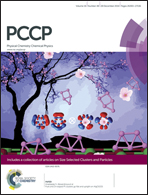A full picture of enzymatic catalysis by hydroxynitrile lyases from Hevea brasiliensis: protonation dependent reaction steps and residue-gated movement of the substrate and the product†
Abstract
Hydroxynitrile lyases (HNLs) defend plants from herbivores and microbial attack by releasing cyanide from hydroxynitriles. The reverse process has been productively applied to bioorganic syntheses of pharmaceuticals and agrochemicals. To improve our understanding of the catalytic mechanism of HNLs, extensive ab initio QM/MM and classical MM molecular dynamics simulations have been performed to explore the catalytic conversion of cyanohydrins into aldehyde (or ketone) and HCN by hydroxynitrile lyases from Hevea brasiliensis (HbHNLs). It was found that the catalytic reaction approximately follows a two-stage mechanism. The first stage involves two fast processes including the proton abstraction of the substrate through a double-proton transfer and the C–CN bond cleavage, while the second stage concerns HCN formation and is rate-determining. The complete free energy profile exhibits a peak of ∼18 kcal mol−1. Interestingly, the protonation state of Lys236 influences the efficiency of the enzyme only to some extent, but it changes the entire catalytic mechanism. The dynamical behaviors of substrate delivery and HCN release are basically modulated by the gate movement of Trp128. The remarkable exothermicity of substrate binding and the facile release of HCN may drive the enzyme-catalyzed reaction to proceed along the substrate decomposition efficiently. Computational mutagenesis reveals the key residues which play an important role in the catalytic process.


 Please wait while we load your content...
Please wait while we load your content...